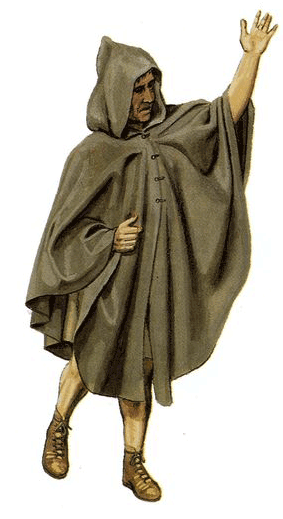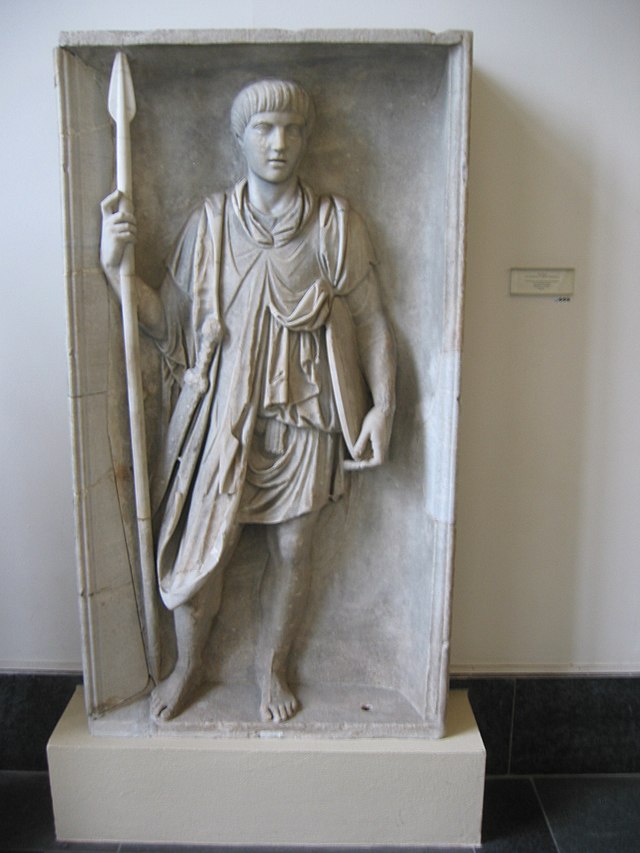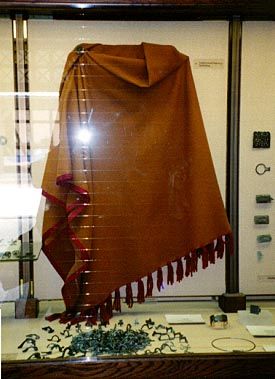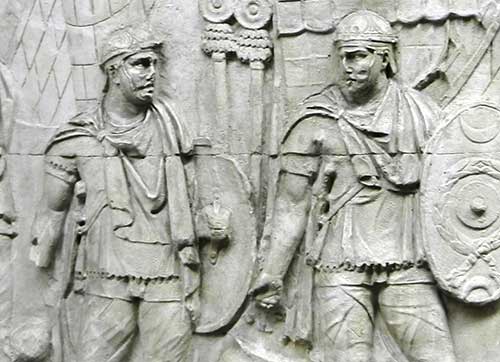The Paenlula and Sagum — The Roman Cloak
Two types of cloaks were used, the paenula and the sagum. Both types of cloak seem to have been some shade of brown or yellowish-brown in color; apparently a particular type of wool was preferred, its natural oils making the fabric nearly waterproof. On campaign, the cloak doubled as the soldier's bedroll. They were fastened with a fibula (a big cloak pin). The paenula was hooded in colder climates. Since every common soldier slept in the open, it was important that he have a warm full-length wrap, but necessary that he carry it with him each day regardless of his activities. This was accomplished by a cloak of more than body length, double-folded so that it did not fall beneath the knees when worn. An excellent illustration of this is the statue of Caesar Augustus atop the theater in the Roman city of Orange, in what is now France.
Paenula (cloak)

The paenula is believed to have been semi-circular, circular, or oval. A circular or semi-circular pattern should be at least 45" in radius, and can be made from 2 or more pieces sewn together with a flat overlap seam. An oval should be about 60" wide by about 3 yards long. In any case, the paenula should be knee-length or longer. A semi-circle is closed at the front either with pins, toggles, or hooks. A circle or oval has a neck hole (ca. 6" diameter) and the front is slit open, partway or all the way to the neck opening, with similar closures. The paenula can have a hood about 12" square sewn to the neck hole, or to a semi-circular cutout in the straight edge of the semi-circular type.

The relief depicts a Roman Praetorian, a member of the Roman elite forces and bodyguard of the Emperor. He wears a Tunica with the Paenula (a cone-shaped cloak made of linen or over it. The tunica is pulled up to knee height by a belt (cingulum), part of which can be seen poking out from under the paenula. He carries a small shield, called a parma, under his left arm and his sword hangs over his shoulder on the other side. In his hand he holds a short Iaculum (javelin)
Sagum
 Roman soldiers often wore a thick warm rectangular cloak called the sagum. It was used to protect the soldier from bad weather on the march or during sentry duty and, it doubled as a blanket at night. Cloaks were fixed in place by a metal brooch called a fiblula (pl. fiblulae).
Roman soldiers often wore a thick warm rectangular cloak called the sagum. It was used to protect the soldier from bad weather on the march or during sentry duty and, it doubled as a blanket at night. Cloaks were fixed in place by a metal brooch called a fiblula (pl. fiblulae).  The sagum is rectangular, blanket-sized or larger and usually had a fringe or Orbiculi It is simply pinned with a fibula at the shoulder or throat.
The sagum is rectangular, blanket-sized or larger and usually had a fringe or Orbiculi It is simply pinned with a fibula at the shoulder or throat.
These cloaks were often left with the natural sheep oils in, keeping them waterproof (though smelly!). They varied in colour and, since they weren't dyed, they were the natural colour of the sheep that the wool was taken from.
The Sagum was the cloak worn by the Roman soldiers and inferior officers, in contradistinction to the Paludamentum of the general and superior officers. It is used in opposition to the toga or garb of peace, and we accordingly find that when there was a war in Italy, all citizens put on the sagum even in the city, with the exception of those of consular rank (saga sumere, ad saga ire, in sagis esse, Cic. Phil. VIII.11, V.12, XIV.1): hence in the Social or Marsic war the sagum was worn for two years (Liv. Epit. 72, 73; Vell. Pat. II.16).
The Sagum is used in opposition to the toga or garb of peace, and we accordingly find that when there was a war in Italy, all citizens put on the sagum even in the city, with the exception of those of consular rank (saga sumere, ad saga ire, in sagis esse, Cic. Phil. VIII.11, V.12, XIV.1): hence in the Social or Marsic war the sagum was worn for two years (Liv. Epit. 72, 73; Vell. Pat. II.16).

Depictions of sagi worn by soldiers, depicted on Trajan's Column.




















